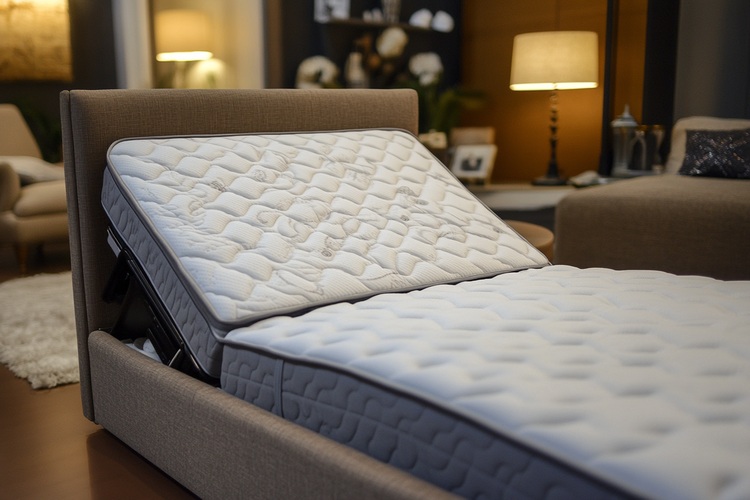Adjustable Beds: Modern Sleep Solutions for Better Rest
Adjustable beds have transformed from hospital equipment to popular home sleep solutions, offering customizable positioning and enhanced comfort features. These innovative bed systems allow users to elevate different sections of the sleeping surface, providing personalized support for various sleep preferences, health conditions, and lifestyle needs. Understanding their features, benefits, and suitability can help determine if an adjustable bed is the right choice for your bedroom.

What Features Are Commonly Found in Adjustable Beds
Modern adjustable beds come equipped with numerous features designed to enhance sleep quality and convenience. The primary feature is the motorized base that allows independent adjustment of the head and foot sections, typically offering elevation angles from flat to nearly 90 degrees. Most models include wireless remote controls with preset positions for activities like reading, watching television, or achieving zero-gravity positioning.
Additional features often include massage functions with multiple intensity levels and targeted zones, USB charging ports for devices, under-bed lighting for nighttime navigation, and memory settings that save preferred positions. Higher-end models may feature smartphone app connectivity, voice control compatibility, and even sleep tracking capabilities that monitor movement and breathing patterns throughout the night.
How Do Adjustable Beds Typically Support Comfort and Sleep Positioning
Adjustable beds provide significant comfort advantages through their ability to accommodate natural body contours and individual sleep preferences. By elevating the upper body, these beds can reduce pressure on the spine, potentially alleviating back pain and improving circulation. The zero-gravity position, which slightly elevates both the head and feet, distributes body weight evenly and may reduce pressure points.
For side sleepers, adjustable beds can be positioned to maintain proper spinal alignment, while back sleepers benefit from customized support that reduces strain on the lower back. The ability to elevate the legs can improve circulation, reduce swelling, and provide relief for conditions like restless leg syndrome. Many users find that adjustable positioning helps with breathing issues, acid reflux, and snoring by keeping the upper body slightly elevated during sleep.
When Might an Adjustable Bed Be a Suitable Choice for Home Use
Adjustable beds prove particularly beneficial for individuals with specific health conditions or comfort preferences. Those experiencing chronic back pain, arthritis, or circulation issues often find relief through customized positioning. People with sleep apnea, acid reflux, or respiratory conditions may benefit from elevated sleeping positions that improve breathing and reduce symptoms.
Beyond medical considerations, adjustable beds suit active lifestyles and aging-in-place goals. Couples with different sleep preferences can benefit from split-adjustable models that allow independent positioning on each side. Individuals who frequently read, work, or watch television in bed appreciate the convenience of adjustable positioning without using multiple pillows for support.
How Adjustable Beds Might Differ from Traditional Bed Setups in Function and Design
The fundamental difference between adjustable and traditional beds lies in their mechanical capabilities and structural design. Traditional beds consist of a static frame supporting a mattress, while adjustable beds feature motorized bases with articulating sections that move independently. This mechanical complexity requires specific mattress types, typically memory foam, latex, or specialized innerspring designs that can flex without damage.
Design-wise, adjustable beds often appear bulkier than traditional frames due to the motor housing and mechanical components. They require electrical connections and may produce minimal noise during adjustment. Traditional beds offer simpler maintenance and typically cost less initially, while adjustable beds provide functionality that traditional setups cannot match through positioning alone.
Adjustable bed pricing varies significantly based on features, size, and brand quality. Basic models typically range from $800 to $1,500 for queen size, while premium options with advanced features can cost $2,000 to $4,000 or more. The following comparison shows typical price ranges for popular adjustable bed categories:
| Category | Price Range (Queen) | Key Features | Target User |
|---|---|---|---|
| Basic Models | $800 - $1,500 | Head/foot adjustment, basic remote | Budget-conscious buyers |
| Mid-Range | $1,500 - $2,500 | Massage, USB ports, presets | General comfort seekers |
| Premium | $2,500 - $4,000+ | Smart connectivity, advanced massage | Tech-savvy users |
| Split-King | $2,000 - $5,000+ | Dual adjustment, separate controls | Couples with different needs |
Prices, rates, or cost estimates mentioned in this article are based on the latest available information but may change over time. Independent research is advised before making financial decisions.
The investment in an adjustable bed should be weighed against potential sleep quality improvements and health benefits. Many users report better sleep quality, reduced pain, and improved overall comfort that justifies the higher initial cost compared to traditional bed setups. Consider factors like warranty coverage, delivery and setup services, and compatibility with existing mattresses when evaluating options.
Adjustable beds represent a significant advancement in sleep technology, offering personalized comfort solutions that traditional beds cannot provide. While they require a higher initial investment and specific considerations for mattress compatibility, the potential benefits for sleep quality, comfort, and health management make them an attractive option for many households. Whether addressing specific health needs or simply seeking enhanced comfort, adjustable beds provide versatile solutions that adapt to individual preferences and changing needs over time.




